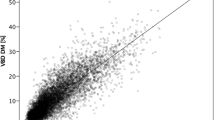Abstract
Objective
To compare breast density on digital mammography and digital breast tomosynthesis using fully automated software.
Methods
Following institutional approval and written informed consent from all participating women, both digital breast tomosynthesis (DBT) and full-field digital mammography (FFDM) were obtained. Breast percentage density was calculated with software on DBT and FFDM.
Results
Fifty consecutive patients (mean age, 51 years; range, 35–83 years) underwent both FFDM and DBT. Using a method based on the integral curve, breast density showed higher results on FFDM (68.1 ± 12.1 for FFDM and 51.9 ± 6.5 for DBT). FFDM overestimated breast density in 16.2% (P < 0.0001). Using a method based on maximum entropy thresholding, breast density showed higher results on FFDM (68.1 ± 12.1 for FFDM and 51.9 ± 6.5 for DBT). FFDM overestimated breast density in 11.4% (P < 0.0001). There was a good correlation among BI-RADS categories on a four-grade scale and the density evaluated with DBT and FFDM (r = 0.54, P < 0.01 and r = 0.44, P < 0.01).
Conclusion
Breast density appeared to be significantly underestimated on digital breast tomosynthesis.
Key Points
-
Breast density is considered to be an independent risk factor for cancer
-
Density can be assessed on full-field digital mammography and digital breast tomosynthesis
-
Objective automated estimation of breast density eliminates subjectivity
-
Automated estimation is more accurate than BI-RADS quantitative evaluation
-
Breast density may be significantly underestimated on digital breast tomosynthesis

Similar content being viewed by others
References
Lehman CD, Blume JD, Weatherall P et al (2005) Screening women at high risk for breast cancer with mammography and magnetic resonance imaging. Cancer 103:1898–1905
Sardanelli F, Podo F, Santoro F et al; High Breast Cancer Risk Italian 1 (HIBCRIT-1) Study (2011) Multicenter surveillance of women at high genetic breast cancer risk using mammography, ultrasonography, and contrast-enhanced magnetic resonance imaging (the high breast cancer risk Italian 1 study): final results. Invest Radiol 46:94–105
Sardanelli F, Podo F, D’Agnolo G, Trial High Breast Cancer Risk Italian et al (2007) Multicenter comparative multimodality surveillance of women at genetic-familial high risk for breast cancer (HIBCRIT study): interim results. Radiology 242:698–715
Harvey JA, Bovbjerg VE (2004) Quantitative assessment of mammographic breast density: relationship with breast cancer risk. Radiology 230:29–41
Highnam R, Jeffreys M, McCormack V et al (2007) Comparing measurements of breast density. Phys Med Biol 52:5881–5895
Diorio C, Pollak M, Byrne C et al (2005) Insulin-like growth factor-I, IGF-binding protein-3, and mammographic breast density. Cancer Epidemiol Biomarkers Prev 14:1065–1073
Gram IT, Funkhouser E, Tabar L (1997) The Tabar classification of mammographic parenchymal patterns. Eur J Radiol 24:131–136
Gram IT, Bremnes Y, Ursin G, Maskarinec G, Bjurstam N, Lund E (2005) Percentage density, Wolfe’s and Tabar’s mammographic patterns: agreement and association with risk factors for breast cancer. Breast Cancer Res 7:R854–R861
Boyd NF, Byng JW, Jong RA et al (1995) Quantitative classification of mammographic densities and breast cancer risk: results from the Canadian National Breast Screening Study. J Natl Cancer Inst 87:670–675
Bakic PR, Carton AK, Kontos D, Zhang C, Troxel AB, Maidment AD (2009) Breast percent density: estimation on digital mammograms and central tomosynthesis projections. Radiology 252:40–49
Tagliafico A, Tagliafico G, Tosto S et al (2009) Mammographic density estimation: comparison among BI-RADS categories, a semi-automated software and a fully automated one. Breast 18:35–40
Niklason LT, Christian BT, Niklason LE et al (1997) Digital tomosynthesis in breast imaging. Radiology 205:399–406
Gur D, Abrams GS, Chough DM et al (2009) Digital breast tomosynthesis: observer performance study. AJR Am J Roentgenol 193:586–591
Tagliafico A, Calabrese M, Tagliafico G et al (2011) Increased mammographic breast density in acromegaly: quantitative and qualitative assessment. Eur J Endocrinol 164:335–340
European Reference Organisation for Quality Assured Breast Screening and Diagnostic Services. http://www.euref.org. Accessed May 17, 2011
Dance DR, Young KC, van Engen RE (2011) Estimation of mean glandular dose for breast tomosynthesis: factors for use with the UK, European and IAEA breast dosimetry protocols. Phys Med Biol 56:453–471
Cavagnetto F, Bampi R, Calabrese M, Orlando B, Villa A, Taccini G (2011) Comparison of dose in digital breast tomosynthesis (DBT) and full-field digital mammography (FFDM). doi: 10.1594/ecr2011/C-1997
Boyd NF, Guo H, Martin LJ et al (2007) Mammographic density and the risk and detection of breast cancer. N Engl J Med 356:227–232
Tagliafico A, Astengo D, Cavagnetto F et al (2011) One-to-one comparison between digital spot compression view and digital breast tomosynthesis. Eur Radiol. doi:10.1007/s00330-011-2305-1
Gennaro G, Toledano A, di Maggio C et al (2010) Digital breast tomosynthesis versus digital mammography: a clinical performance study. Eur Radiol 20:1545–1553
Author information
Authors and Affiliations
Corresponding author
Rights and permissions
About this article
Cite this article
Tagliafico, A., Tagliafico, G., Astengo, D. et al. Mammographic density estimation: one-to-one comparison of digital mammography and digital breast tomosynthesis using fully automated software. Eur Radiol 22, 1265–1270 (2012). https://doi.org/10.1007/s00330-012-2380-y
Received:
Revised:
Accepted:
Published:
Issue Date:
DOI: https://doi.org/10.1007/s00330-012-2380-y




